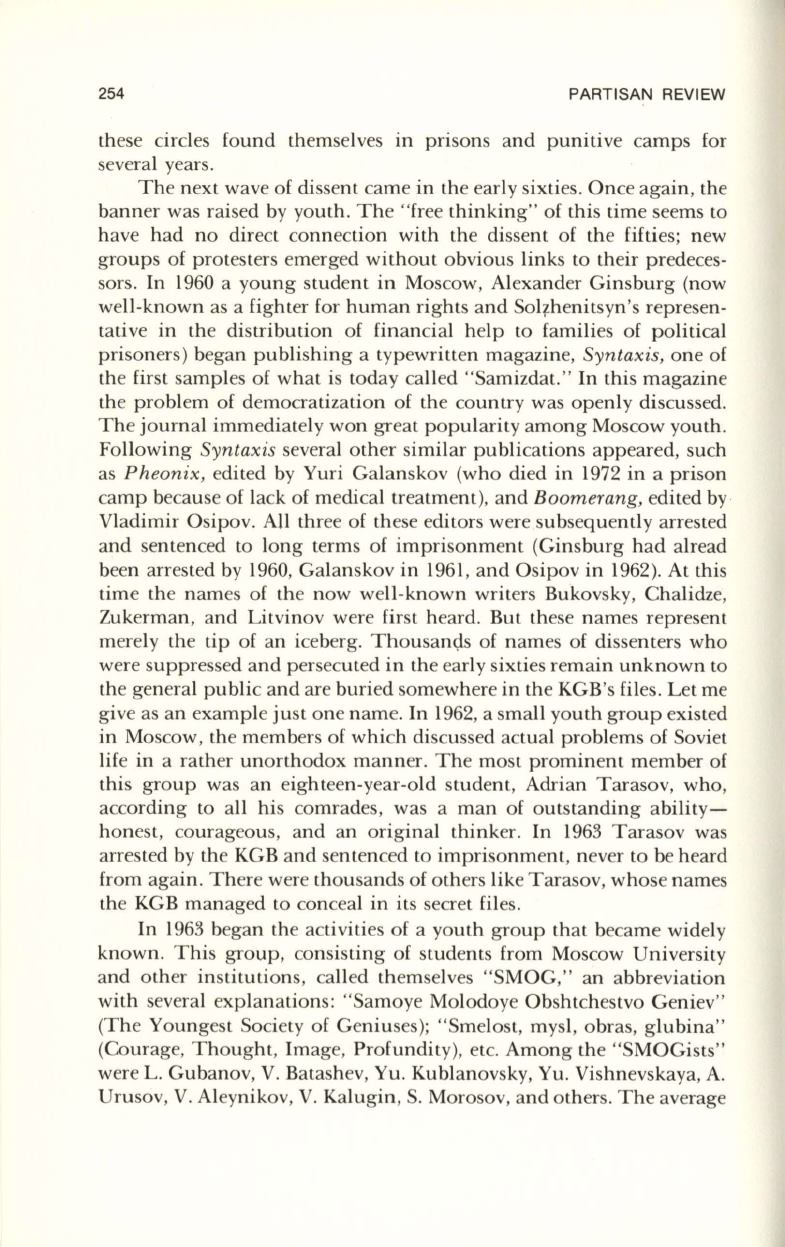
254
PARTISAN REVIEW
these circles found themselves in prisons and punitive camps for
several years.
The next wave of dissent came in the early sixties. Once again, the
banner was raised by youth. The "free thinking" of this time seems to
have had no direct connection with the dissent of the fifties; new
groups of protesters emerged without obvious links to their predeces–
sors. In 1960 a young student in Moscow, Alexander Ginsburg (now
well-known as a fighter for human rights and Sol?:henitsyn's represen–
tative in the distribution of financial help to families of political
prisoners) began publishing a typewritten magazine,
Syntaxis,
one of
the first samples of what is today called "Samizdat." In this magazine
the problem of democratization of the country was openly discussed.
The journal immediately won great popularity among Moscow youth.
Following
Syntaxis
several other similar publications appeared, such
as
Pheonix,
edited by Yuri Galanskov (who died in 1972 in a prison
camp because of lack of medical treatment), and
Boomerang,
edited by
Vladimir Osipov. All three of these editors were subsequently arrested
and sentenced to long terms of imprisonment (Ginsburg had alread
been arrested by 1960, Galanskov in 1961 , and Osipov in 1962). At this
time the names of the now well-known writers Bukovsky, Chalidze,
Zukerman, and Litvinov were first heard. But these names represent
merely the tip of an iceberg. Thousan<;ls of names of dissenters who
were suppressed and persecuted in the early sixties remain unknown
to
the general public and are buried somewhere in the KGB's files. Let me
give as an example just one name. In 1962, a small youth group existed
in Moscow, the members of which discussed actual problems of Soviet
life in a rather unorthodox manner. The most prominent member of
this group was an eighteen-year-old student, Adrian Tarasov, who,
according to all his comrades, was a man of outstanding ability–
honest, courageous, and an original thinker. In 1963 Tarasov was
arrested by the KGB and sentenced to imprisonment, never to be heard
from again. There were thousands of others like Tarasov, whose names
the KGB managed
to
conceal in its secret files.
In 1963 began the activities of a youth group that became widely
known. This group, consisting of students from Moscow University
and other institutions, called themselves "SMOG," an abbreviation
with several explanations: "Samoye Molodoye Obshtchestvo Geniev"
(The Youngest Society of Geniuses); "Smelost, mysl, obras, glubina"
(Courage, Thought, Image, Profundity), etc. Among the "SMOGists"
were
L.
Gubanov, V. Batashev, Yu. Kublanovsky, Yu. Vishnevskaya, A.
Urusov, V. Aleynikov, V. Kalugin, S. Morosov, and others. The average


